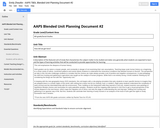
This unit emphasizes the diaspora of human history.
Sixth graders are by nature a myopic people, and constantly in danger of not examining their own assumptions. Teaching large scale human history as a beginning to a closer study of culture, movement patterns and events allows students to understand the miraculous conditions that allowed humans to flourish. The perspective we take in this unit also challenges students to consider that the choices we make always provide a set of positive and negative consequences. In past pedagogy, the shift from hunting and gathering to agriculture was taught as the catalyst of human progress. While that is not entirely wrong, it limits students' thinking by not considering the things we lost with this "opportunity cost."
In keeping with the new geography-heavy 2015 standards, this unit begins with a role-playing simulation that asks students to learn specific biomes to imagine they are plopped down in a certain region of the world, with nothing but a basic tool kit (no clothing, food, or shelter!). Right away students understand the complexity of early survival and the interrelationship with the environment. Then, building on the interpretive skills they learned in Unit one, student examine cave paintings to hypothesis lifestyle choices and necessities for early paleolithic peoples. Students recall the mapping skills learned in Unit One to get a visual perspective of the human diaspora in the next lesson, which maps the migration out of Africa, and sets the stage to understanding the next big topic: shifting from hunting and gathering to an agrarian way of life. But first, students will culminate their learning of early humans in an analysis of the issue of who gets the rights to study Kennewick man's remains.
**From the new AAPS 6th grade curriculum; written by Rachel Toon for ATLAS
- Subject:
- History
- World History
- Material Type:
- Unit of Study
- Provider:
- Michigan Virtual
- Author:
- Emily Zheutlin
- Date Added:
- 10/11/2017
